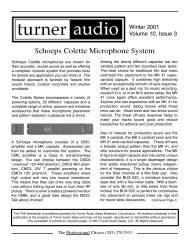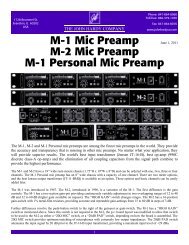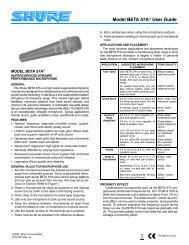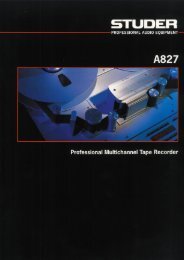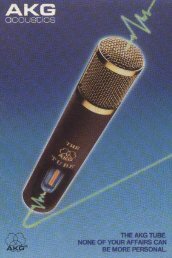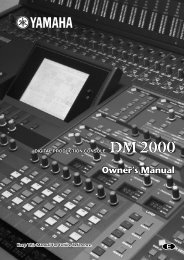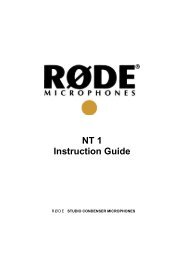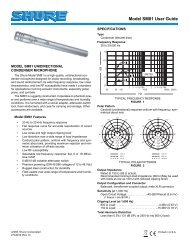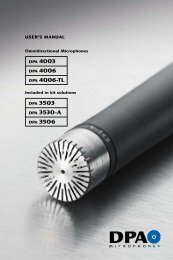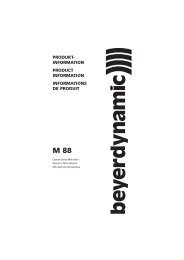Lexicon 480L | PDF - Freeverb3
Lexicon 480L | PDF - Freeverb3
Lexicon 480L | PDF - Freeverb3
Create successful ePaper yourself
Turn your PDF publications into a flip-book with our unique Google optimized e-Paper software.
<strong>Lexicon</strong> <strong>480L</strong> Owner's Manual<br />
WANDER<br />
WANDER sets the amount of wander in each direction<br />
that the delay will move.<br />
NUMBER<br />
NUMBER sets the number of voices used.<br />
PREDELAY<br />
PREDELAY sets the delay before the effect begins.<br />
Page Two<br />
INPUT BLEND (labeled "MON")<br />
INPUT BLEND allows manipulation of the input configuration,<br />
from normal stereo through mono, to reverse<br />
stereo. The Effects algorithm operates in true stereo.<br />
When INPUT BLEND is set to stereo, the left output is<br />
derived only from the left input, and the right output is<br />
derived only from the right input. So if you are trying to<br />
create an effect with sound movement from one output<br />
to the other, INPUT BLEND should be set to mono.<br />
FEEDBACK LEVEL<br />
FEEDBACK LEVEL controls the level of signals recirculated<br />
back to the input. Increasing the amount of<br />
feedback can create interesting resonant effects.<br />
FEEDBACK DELAY<br />
FEEDBACK delay sets the delay that occurs between<br />
signal input and the onset of feedback. Try setting<br />
FEEDBACK DELAY to the same value as LENGTH for<br />
interesting effects.<br />
DIFFUSION<br />
DIFFUSION spreads out the input signal over time,<br />
turning sharp transients such as clicks into swishing<br />
sounds.<br />
INPUT DELAY<br />
INPUT DELAY adds delay only to the dry signal path—<br />
it has no effect on the wet signal path. This effectively<br />
allows you to "live in the past," since by delaying the<br />
input you can add an effect that happens before the dry<br />
signal is heard. This only works if you use WET/DRY<br />
MIX to mix the effect with the dry signal. Using the<br />
console to mix will negate the effectiveness of the<br />
INPUT DELAY.<br />
WET/DRY MIX<br />
WET/DRY MIX controls the ratio of direct vs. effect<br />
signal in the output from a program. When the <strong>480L</strong> is<br />
patched into a console, this control should almost<br />
always be set to 100% wet. When an instrument is<br />
plugged directly into a <strong>480L</strong>, or when the Cascade<br />
configuration is in use, a setting between 45 and 60%<br />
is a good starting point for experimentation with this<br />
parameter.<br />
WET/DRY MIX is a sine/cosine fade. Practically<br />
speaking, this means that MIX can be adjusted over its<br />
range with little or no change in output level. When you<br />
control mix at the console, adding effect to the dry<br />
signal increases overall level.<br />
Use of INPUT DELAY can produce effects that actually<br />
happen before the dry signal. When producing these<br />
effects, you must use WET/DRY MIX--controlling the<br />
mix at the console will negate the effect of the input<br />
delay. (See INPUT DELAY for more details).<br />
Page Three<br />
HIGH PASS (Left and Right)<br />
High PASS adjusts a 12 dB/octave filter on each input<br />
channel to attenuate low frequencies.<br />
SIGNS<br />
When the Signs parameter is set to 1, a significant<br />
increase in output gain can occur.<br />
4-4


